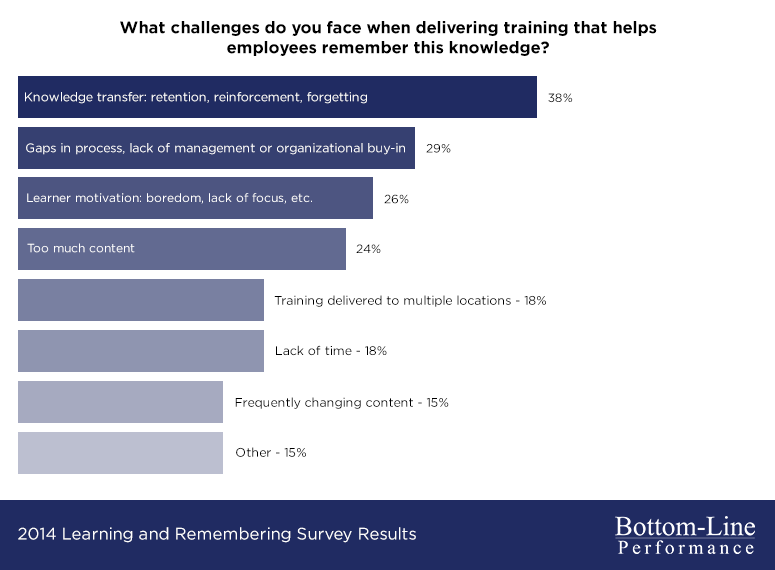
There is a gap in your organization.
On one side, you have your business objectives, your subject matter experts and all of the knowledge, skills and content employees need to know to meet your objectives. On the other side are your employees: human beings trying to do their jobs in an imperfect environment. The bridge between these two sides is where knowledge transfer is supposed to happen… yet many organizations report that knowledge transfer is simply not happening. How do we pass the baton? What’s the problem and how do we fix it?
Respondents to our 2014 Learning and Remembering Survey indicated that they know what effective training looks like, but external limitations and roadblocks prevent them from delivering learning solutions that improve performance. In response to the question “What challenges do you face when delivering training that helps learners remember your most important content,” knowledge transfer was the number one answer (38%). Organizations struggle with employee forgetting, lack of training reinforcement and subsequent gaps in retention.
The other challenges that respondents noted are also related to the knowledge transfer issue:

There are plenty of tried and trued learning strategies for long term retention that can be applied to make knowledge transfer more effective, but they only work when they are applied properly. Unfortunately, the individual tasked with developing and/or delivering training inside an organization is sometimes a subject matter expert in disguise; they know their content but they do not know how to help employees learn it!
Let’s say you lead a functional area in your organization that needs training. Depending on your organization’s structure, you will either reach out to the internal L&D department, outsource to a vendor, or both. You might have a specific metric to hit, or maybe just a boss to please… but either way you expect training to help you meet your goals. What can you do to make sure knowledge transfer happens and the baton gets passed?
Take the time for thorough analysis
The analysis phase of a project can be highly enlightening. Take the time to evaluate your processes, people and current work environment to determine what type of training will be most beneficial. An honest needs analysis can help you discover the process that lacks buy-in or the topic area with too much content related to it. It also helps to…
Get to know your learners
When we start a new project, we often conduct interviews and focus groups with learners to understand their roles, preferences and challenges. Perhaps there is better way to deliver training to your front line staff or a way to streamline a course so it just focuses on essential information? Don’t forget to include management in this process, as their buy-in will be critical to the success of your training.
Embrace the Design Phase
The design phase of a project is the perfect chance to clarify vision and connect the purpose of your training with the goals of senior leadership. Don’t let your internal team, or your vendor, design in a vacuum; we use agile learning design to involve clients early and often with working prototypes and mock-ups that allow potential issues to arise quickly.
No matter what team is designing your learning solution, asking the right questions along the way is essential to keep the focus on knowledge transfer:
- Have we built multiple repetitions of key concepts into this solution?
- How will learners receive corrective feedback?
- Are adequate practice opportunities provided so learners can apply the new knowledge?
- How will the training be reinforced on the job?
Avoid Learning “Myths”
Sometimes, training that is designed with knowledge transfer fails because the instructional design was not sound. Ever heard someone mention learning styles? Sharon Boller outlines several commonly cited learning “theories” that are actually myths in this article.
In the end…
Knowledge transfer is not as complicated as our industry makes it out to be. Most of us intuitively know good learning design when we see it, and the concepts seem common-sensical when they are explained. The real challenge is to know when instructional approaches need to be modified… and when some other barrier such as inconsistent buy-in or an ineffective technology are the real reasons for poor knowledge transfer.
[av_promobox button=’yes’ label=’Get It Now’ link=’page,11955′ link_target=” color=’theme-color’ custom_bg=’#444444′ custom_font=’#ffffff’ size=’large’ icon_select=’no’ icon=’ue800′ font=’entypo-fontello’ box_color=” box_custom_font=’#ffffff’ box_custom_bg=’#444444′ box_custom_border=’#333333′]
Is your current training effective? Are you getting the information across? Use our Self Assessment for Your eLearning Program to find out where you stand.
[/av_promobox]



